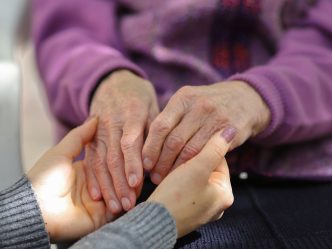Moniqua Acosta and Olivia Lindsey with Space Yoga Studio, share part of a 45-minute yoga routine to help cancer patients heal their body and mind.
Yoga + Wellness
Despite its ancient origins, yoga has been launched into mainstream culture with the help of niche combination interests like: cat yoga, wine yoga, hot yoga, and any other “word” + yoga combination you could ever want in your weekends. While the different types of yoga classes you can attend seem endless, one thing remains the same through the centuries— yoga can be a beneficial low-impact exercise to manage a variety of ailments. Just to name a few: heart disease, diabetes, sleep troubles, body aches, body pains, mental health issues and stress.
At the Georgia Cancer Center, studies are being conducted to learn how yoga can relieve stress, pain, fatigue and sleep disorders in cancer patients. Moniqua Acosta, owner of Space Yoga Studio, teaches yoga classes for cancer patients that focus on low impact movements designed to promote circulation and improve muscle movement. Acosta is certified at the level of Experienced Registered Yoga Teacher-200 with Yoga Alliance and is a supporting member of the International Association of Yoga Therapists and the Yoga Service Council. She works closely with Clinical Yoga Therapists and Physical Therapists in the area who helped pioneer holistic programs all around the CSRA.
“When properly integrated into treatment, yoga therapy can bring about massive changes in the quality of life of the patients by decreasing undesirable symptoms such as depression, insomnia, anxiety, and fatigue,” says Acosta. “Yoga allows greater ease in pain management, and, most importantly, provides the patients with tools that can help them make difficult transitions in their journey with disease.”
Yoga for Cancer Patients
Some benefits of practicing yoga during treatment include:
- Deep, relaxing breathing techniques emphasized in yoga practices can increase red blood cell circulation to extremities, helping remove toxins collected during treatment and re-energizing cells.
- Some routines can last as long as an hour or as little as 15 minutes. This provides a great range of whole-body, low-impact exercises for patients who may not feel up to a more developed exercise routine. Short or long, these practices can improve flexibility, strength, muscle mass and balance in every-day wellness, after surgery or extended bed rest.
- Some patients may experience insomnia and trouble sleeping. Yoga has been linked to lower cortisol levels, which reduce stress and relax the body. You can even do some poses in bed!
- Child’s Pose
- Reclining Bound Angle Pose
- Wind-Relieving Pose
- Reclining Twist, use a pillow between your legs for support.
Since yoga can put strain on ligaments and joints, start your practice under the supervision of a certified teacher. Physical therapists and oncologists may be able to recommend practices or guidelines, and with any activity during treatment, discuss it with your care team.




